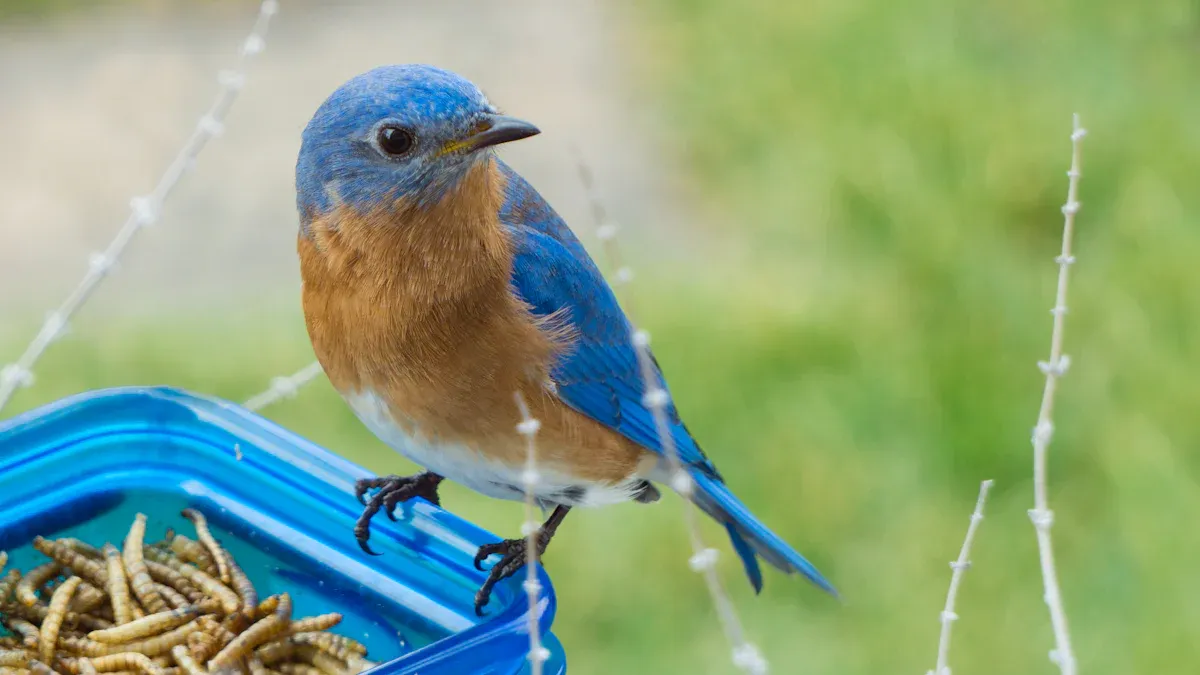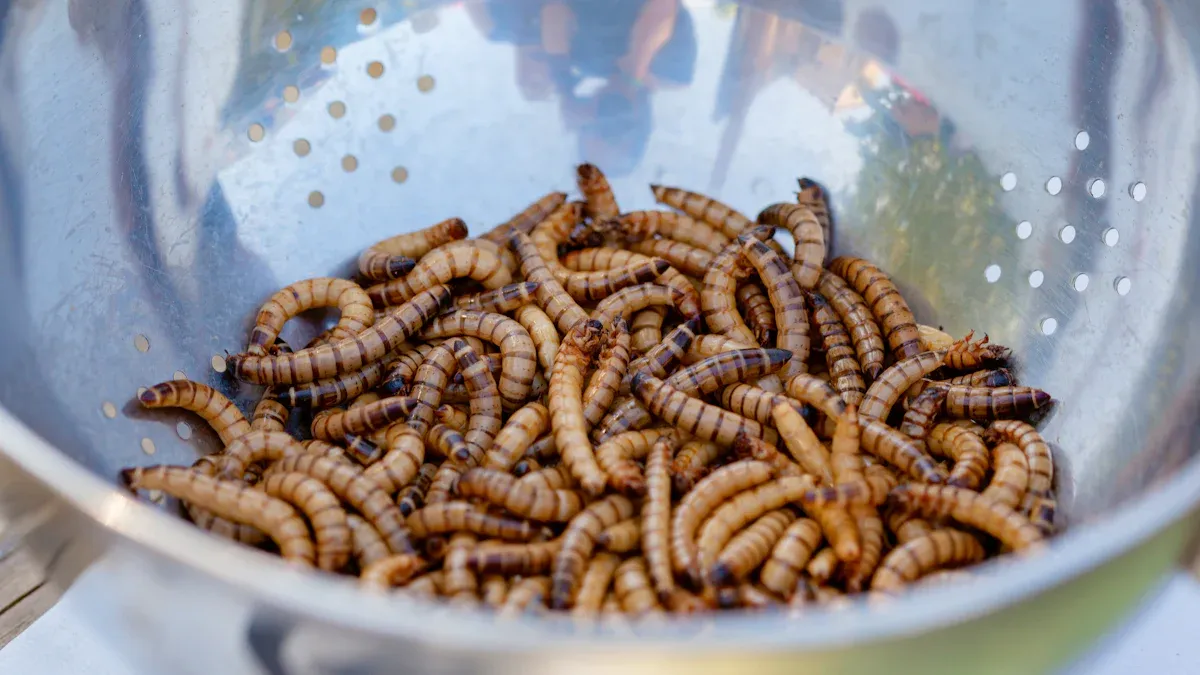
Mealworms offer parrots and wild birds a protein boost no other food can match. Just look at the numbers:
| Protein Source | Crude Protein (%) |
|---|---|
| Mealworms | 43.3 – 60.2 |
| Soybean Meal | 49.4 |
Packed with about 19% fat and rich nutrients, they support energy and health. Dried mealworms are a top pick for anyone looking for convenient, nutritious meal worms for wild birds.
Key Takeaways
- Mealworms provide high protein and fat that help birds grow strong, stay active, and get energy, making them a top choice for bird nutrition.
- Birds naturally prefer mealworms because they resemble insects found in the wild and support their health and social behavior.
- Feeding mealworms safely means offering them in moderation, choosing live or dried forms based on convenience, and avoiding overfeeding to keep birds healthy.
Nutritional Benefits of Meal Worms for Wild Birds and Parrots

High Protein, Fat, and Essential Nutrients
Mealworms pack a powerful punch when it comes to nutrition. Scientists have studied mealworms and found that they can contain up to 70% protein by dry weight. This high protein level helps birds build strong muscles, grow healthy feathers, and stay active. Mealworms also provide a good amount of fat, which gives birds the energy they need, especially during cold weather or breeding season.
Mealworms are not just about protein and fat. They also offer all the essential amino acids, like leucine, isoleucine, arginine, glycine, and valine. These nutrients help with muscle growth, immune health, and tissue repair. Studies show that the diet of mealworms can change their nutrient content, but even so, they always remain a reliable source of high-quality protein and fat.
Dried mealworms, such as our 100% natural product, make it easy to give wild birds and parrots this nutrition boost. They are packed with protein, vitamins, and healthy oils, making them a smart choice for anyone looking for meal worms for wild birds.
Tip: Dried mealworms are easy to store and can be mixed with other bird foods for extra nutrition.
Comparison to Other Protein Sources
How do mealworms stack up against other common protein sources? Let’s take a look:
| Nutrient Category | Mealworms (dry) | Soybean Meal | Fish Meal |
|---|---|---|---|
| Protein (%) | 40.2–63.3 | 49.4 | 60–72 |
| Fat (%) | 22.3–39.5 | 1.2 | 8–12 |
| Amino Acids | Rich & diverse | Good | Good |
| Minerals (mg/kg) | High in K, Mg | High in Mg | High in K |
Mealworms offer a higher fat content than soybean meal and fish meal, which is important for energy. Their amino acid profile is rich and diverse, supporting growth and health. Mealworms also provide more potassium and magnesium than many other protein sources.
Birds digest mealworms easily, just like seeds, but mealworms have fewer antinutritional factors than plant-based proteins. Studies show that birds eating mealworm-based diets grow well and use the protein efficiently. In fact, meal worms for wild birds can replace up to 100% of soybean meal in bird diets without any negative effects.
- Mealworms have 47-60% protein and 31-43% fat, making them a top choice for bird nutrition.
- Birds fed mealworm diets show improved growth and better nutrient absorption.
- Mealworms do not cause digestive problems and are easy for birds to eat.
Why Birds Naturally Prefer Mealworms
Birds love mealworms, and there’s science behind it. Many wild birds, like bluebirds and robins, are naturally drawn to mealworms because they are similar to the insects birds would find in the wild. Researchers have seen birds share mealworms during winter and while raising their young. This sharing helps birds survive cold weather and strengthens social bonds.
Live mealworms move, which triggers birds’ hunting instincts. Even dried mealworms attract a wide range of species, though some birds may need a little time to get used to them. Studies show that birds will often choose mealworms over other foods, even when presented with something new or unfamiliar. For example, great tits quickly ate mealworms from brightly colored plates, showing little fear.
A study with starlings found that birds ate more mealworms than other foods, and when mealworms were replaced with less preferred foods, the birds ate less. This shows that mealworms are not just a treat—they are a favorite food that birds instinctively seek out.
If you want to attract more birds to your yard, offering meal worms for wild birds is a great way to do it. Birds recognize the nutritional value and respond with enthusiasm.
How to Feed Meal Worms for Wild Birds and Parrots Safely
Live vs. Dried Mealworms: Which to Choose
Birds often show a clear preference for live mealworms. Chickadees and nuthatches, for example, will pick live or even frozen mealworms before dried ones. Live mealworms move, which attracts birds’ attention and triggers their natural hunting instincts. However, dried mealworms offer a convenient and nutritious alternative. They store easily and last longer, making them a practical choice for many bird owners. Studies using near-infrared reflectance spectroscopy show that drying mealworms increases their carbohydrate and ash content, while protein levels remain similar. Some birds may need time to accept dried mealworms, but moistening them can help.
Best Feeding Methods and Tips
Many bird lovers sprinkle meal worms for wild birds on the ground, in trays, or in special feeders. Mixing mealworms with other foods, like seeds or fruit, encourages birds to try them. Farmers and pet owners often harvest mealworms before they turn into beetles and mix them with other feed. For best results, use wheat bran as a base diet for mealworms, sometimes adding yeast to boost their nutrition.
Tip: Place feeders away from nestboxes to avoid attracting unwanted pests.
How Much and How Often to Feed
Experts suggest feeding about 15 mealworms per bluebird each day as a supplement. Most birds do well with mealworms once or twice daily. Studies recommend that mealworms make up no more than 10% of a bird’s total diet. This helps keep their meals balanced and healthy.
Cautions and Limitations
Mealworms are safe for most birds, but overfeeding can cause problems. Some mealworms may carry parasites or allergens, especially if not raised properly. Freezing or cooking mealworms before feeding reduces these risks. Avoid feeding “giant” mealworms treated with hormones. Always monitor birds for any signs of allergies or digestive issues.
Mealworms stand out as a top choice for bird nutrition. Studies show birds fed meal worms for wild birds gain weight, boost immunity, and raise more chicks.
| Benefit | Result |
|---|---|
| Fledging success | Improved with mealworms |
| Parasite prevalence | Reduced |
| Chick survival | Enhanced |
Try adding meal worms for wild birds to your feeding routine and watch your birds thrive.
FAQ
Are dried mealworms safe for all birds?
Dried mealworms are safe for most wild birds and parrots. They provide protein and energy. Always offer them in moderation for best results.
How should someone store dried mealworms?
Store dried mealworms in a cool, dry place. Keep the bag sealed. This keeps them fresh and ready for your birds.
Can birds eat only mealworms?
Birds need a balanced diet. Mealworms work best as a treat or supplement. Mix them with seeds, fruits, or pellets for complete nutrition.


